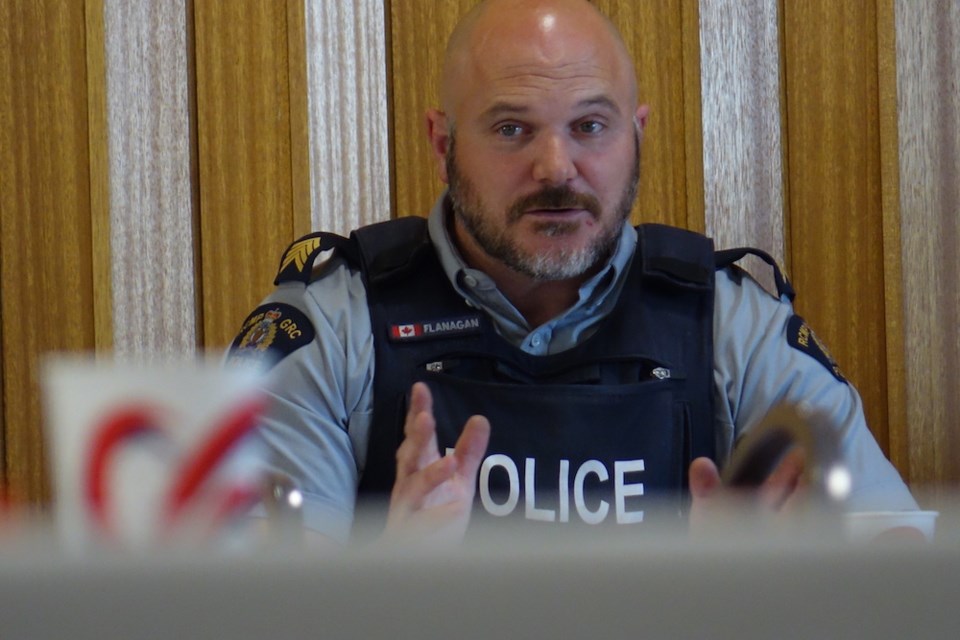An RCMP detachment member delivered a dose of sobering statistics to the Thompson Chamber of Commerce at their last biweekly lunch meeting before their summer break on June 15.
Staff Sgt. Shane Flanagan said that for the first four months of this year — January to April — violent crime in Thompson is up 45 per cent from its five-year average for the same time period and that the city has had three homicides already this year, two of which did not occur during the four-month period covered by the stats.
One of the violent crime hotspots police have identified in the city has long occupied that position — the portion of Eastwood along Princeton Drive.
“It’s responsible for a lot on the east side,” said Flanagan. “And that just goes hand-in-hand with some of the visible socio-economic issues that we are trying to deal with.”
Another location didn’t used to require as many police resources as it does now — the City Centre Mall.
Since the new Liquor Mart opened in the northwest corner of the mall’s parking lot, close to the intersection of Mystery Lake Road and Thompson Drive North, the number of calls for service to that area has skyrocketed.
“There’s obviously a statistically significant increase,” said Flanagan, noting that violent crime is up 100 per cent at 300 Mystery Lake Road from the five-year average, though the area is not the epicentre of violent crime in Thompson.
Social disorder calls — “unruly characters causing issues in the parking lot and the different stores” — have seen a 230 per cent increase and the number of nuisance, mischief and vandalism calls has gone up 156 per cent.
Flanagan also drew attention to the fact that there are two distinct groups of people on the city’s streets: the older ones who have been here longer and a younger group who congregate in the city for access to alcohol and drugs.
“They come here because there is a place to party,” he said.
As a result, many older homeless people have taken to spending nights in the area of the Canadian Tire parking lot, where they feel safer because the police station is nearby.
“For the most part, that causes very little disruptive nuisance crime. It’s a visual issue but they fear for their safety.” Flanagan said. “For the most part, the regular group are victims of crime,” more so than perpetrators,
It’s often a small group of people who are responsible for a large number of police responses. Flanagan said he was at an earlier meeting with other agencies in the city trying to devise a plan for one particular person, who has been part of 37 calls for police service in the last couple of months. When it comes to mischief and non-violent disturbance calls, about 70 per cent of incidents are related to less than a dozen people.
In previous postings in Grand Rapids and Moose Lake, Flanagan said officers dealt with a lot of incidents related to organized gangs, but said Thompson has been largely free of that for the last decade-plus, dating back to a time when there was a Hells Angles presence in the city. Now, it is no longer a centre for gangs that operate structured criminal enterprises, so much as for unorganized informal gangs. While there are some advantages to this — “Most of these unorganized gangs get disrupted when people got to jail and they just kind of fall apart,” — informal gangs are also less disciplined than actual organized crime groups.
“There’s really no code, per se,” Flanagan said. “They’re all kind of trying to get a name for themselves.”
Intoxication remains one fo the major factors driving calls for service at the Thompson RCMP detachment, Flanagan said, with 310 calls for intoxicated persons in the first four months of this year. There are also mental health issues to deal with, 222 in the first four months of the year, which can sometimes lead to officer spending more than 50 hours in a month waiting with patients at the Thompson General Hospital, acting Thompson detachment officer-in-charge Staff Sgt. Jenny Melanson recently told Thompson city council.
Attending to non-police matters like that, which would probably not involve police at all in larger cities, keep all Thompson RCMP detachment members on their toes at all times.
“We are the busiest detachment per member in Western Canada, stats wise,” said Flanagan, noting that one analysis said Thompson could use 23 additional police officers on top of the 39 it has now, based on the call volume, though Flanagan believes that might be an overestimate, given how many issues that police deal with are not actually crimes but social, mental health and addictions-related issues.
Even if the detachment could have more members — and the City of Thompson which is spending 22 per cent of its budget on police services in 2022, could afford it — the RCMP is not immune to forces affecting all types of organizations and businesses in Canada and elsewhere worldwide at the moment.
“In this day and age, it’s hard to get people even to want to become police officers and apply,” Flanagan said. “We’re seeing that in our recruiting.”
Thompson residents should be prepared to see a larger police presence in the city starting June 20, with additional uniformed and plainclothes officers on patrol to help mitigate the impact of the return of Nickel Days.
“We anticipate an increased population in the city,” he said. “So, with the increased population, we anticipate there will be some increased social problems.”




